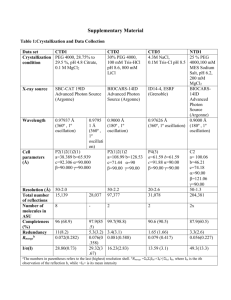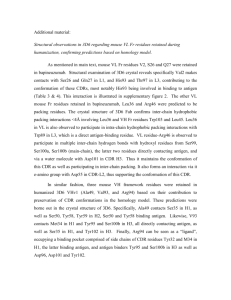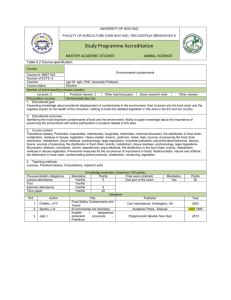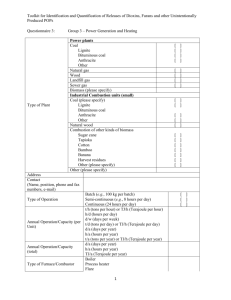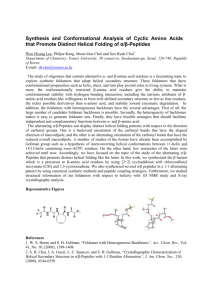Procedures for Residue Control and Financing thereof
advertisement
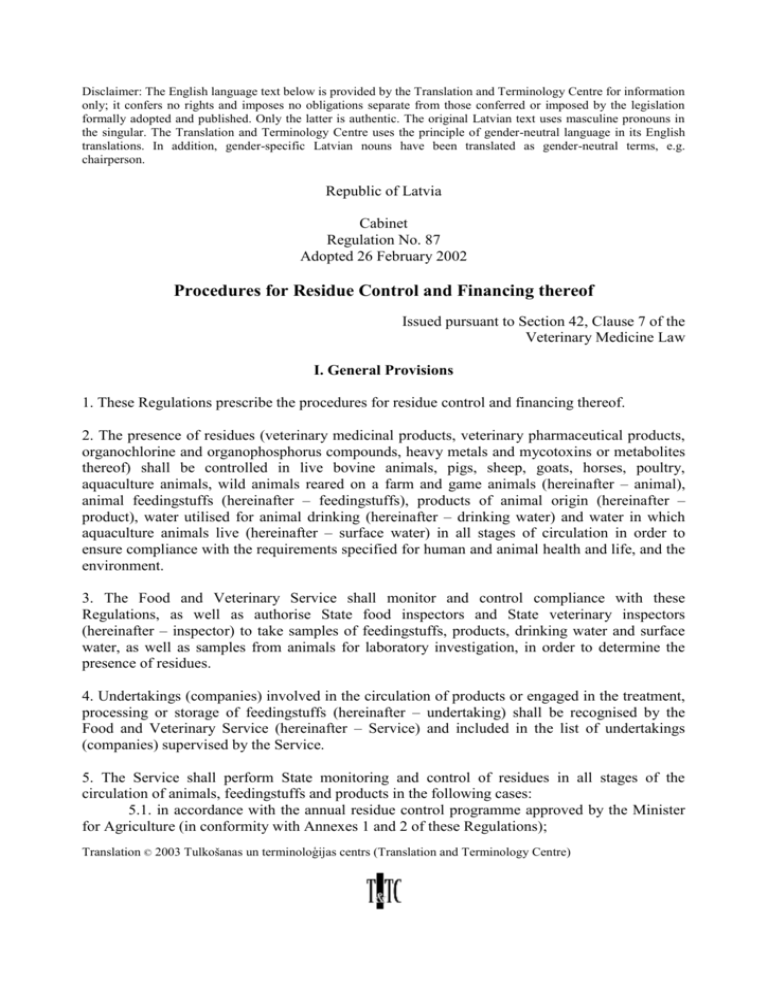
Disclaimer: The English language text below is provided by the Translation and Terminology Centre for information only; it confers no rights and imposes no obligations separate from those conferred or imposed by the legislation formally adopted and published. Only the latter is authentic. The original Latvian text uses masculine pronouns in the singular. The Translation and Terminology Centre uses the principle of gender-neutral language in its English translations. In addition, gender-specific Latvian nouns have been translated as gender-neutral terms, e.g. chairperson. Republic of Latvia Cabinet Regulation No. 87 Adopted 26 February 2002 Procedures for Residue Control and Financing thereof Issued pursuant to Section 42, Clause 7 of the Veterinary Medicine Law I. General Provisions 1. These Regulations prescribe the procedures for residue control and financing thereof. 2. The presence of residues (veterinary medicinal products, veterinary pharmaceutical products, organochlorine and organophosphorus compounds, heavy metals and mycotoxins or metabolites thereof) shall be controlled in live bovine animals, pigs, sheep, goats, horses, poultry, aquaculture animals, wild animals reared on a farm and game animals (hereinafter – animal), animal feedingstuffs (hereinafter – feedingstuffs), products of animal origin (hereinafter – product), water utilised for animal drinking (hereinafter – drinking water) and water in which aquaculture animals live (hereinafter – surface water) in all stages of circulation in order to ensure compliance with the requirements specified for human and animal health and life, and the environment. 3. The Food and Veterinary Service shall monitor and control compliance with these Regulations, as well as authorise State food inspectors and State veterinary inspectors (hereinafter – inspector) to take samples of feedingstuffs, products, drinking water and surface water, as well as samples from animals for laboratory investigation, in order to determine the presence of residues. 4. Undertakings (companies) involved in the circulation of products or engaged in the treatment, processing or storage of feedingstuffs (hereinafter – undertaking) shall be recognised by the Food and Veterinary Service (hereinafter – Service) and included in the list of undertakings (companies) supervised by the Service. 5. The Service shall perform State monitoring and control of residues in all stages of the circulation of animals, feedingstuffs and products in the following cases: 5.1. in accordance with the annual residue control programme approved by the Minister for Agriculture (in conformity with Annexes 1 and 2 of these Regulations); Translation © 2003 Tulkošanas un terminoloģijas centrs (Translation and Terminology Centre) 5.2. if animals are not medically treated in conformity with the requirements specified in regulatory enactments regarding compulsory harmlessness requirements or regarding maximum permissible level of drug residues in products; 5.3. if non-compliance of the amount of residue with the requirements prescribed by regulatory enactments regarding compulsory harmlessness requirements or maximum permissible level of drug residues in products and feedingstuffs, as well as harmlessness requirements of surface water and drinking water has been determined; or 5.4. if there is a suspicion regarding the presence of residues in animals, feedingstuffs, products, surface water or drinking water. 6. An owner of animals, feedingstuffs, products, drinking water or surface water shall be liable for ensuring that the amount of residues does not exceed the maximum permissible level. 7. An animal owner has the following obligations: 7.1. to develop and permanently implement a self-control system; 7.2. to register the use of medicinal products and veterinary pharmaceutical products for animals; 7.3. to keep the medical treatment register of animals for at least five years; 7.4. upon the request of an inspector, to provide information regarding compliance with these Regulations in animal housing; 7.5. to inform an inspector and a veterinarian if non-compliance with compulsory harmlessness requirements in relation to presence of residues specified in regulatory enactments has been determined during laboratory investigations of animals; 7.6. if there is a suspicion regarding the presence of residues, not to take such animals out of the animal housing from which the relevant samples have been taken prior to the receipt of the results of laboratory investigations and instructions regarding further action with animals; 7.7. to cover expenditures for repeated laboratory investigations if it has been determined in the laboratory investigations that the amount of residues exceeds the maximum permissible level; and 7.8. to cover the expenditures regarding the disposal of animals, feedingstuffs or products. 8. An owner of the undertaking, feedingstuffs or products has the following obligations: 8.1. to develop and permanently implement the self-control system; 8.2. to ensure compliance with the restrictions for the utilisation of products and feedingstuffs; 8.3. on the basis of a request from an inspector to provide information regarding compliance with these Regulations; 8.4. to inform an inspector and a veterinarian if non-compliance with compulsory harmlessness requirements in relation to the presence of residues specified in regulatory enactments has been determined in the laboratory investigations of products or feedingstuffs; 8.5. if there is a suspicion regarding the presence of residues, not to take such feedingstuffs or products out of the undertaking from which the relevant samples have been taken before the receipt of the results of the laboratory investigations and instructions regarding further action with feedingstuffs or products; Translation © 2003 Tulkošanas un terminoloģijas centrs (Translation and Terminology Centre) 2 8.6. to cover expenditures for repeated laboratory investigations if it has been determined in the laboratory investigations that the amount of residues exceeds the maximum permissible level; and 8.7. to cover the expenditures for the disposal of feedingstuffs or products. 9. Owners of drinking water and surface water have the following obligations: 9.1. to develop and permanently implement the self-control system; 9.2. to inform an inspector and a veterinarian if non-compliance with the compulsory harmlessness requirements in relation to the presence of residues specified in regulatory enactments has been determined in laboratory investigations of drinking water or surface water; and 9.3. to cover expenditures for repeated laboratory investigations if it has been determined during the laboratory investigations that the amount of residues exceeds the maximum permissible level. II. Annual Residue Control Programme, Financing Procedures Thereof and Sampling Procedures 10. The annual residue control programme (hereinafter – programme) shall be implemented from State budget funds. 11. In order to receive financing for the programme, the Service shall annually: 11.1. estimate financial resources for the implementation of the programme and determine the allocation thereof within the scope of the programme; and 11.2. develop and submit a draft programme to the Ministry of Agriculture. 12. The draft programme shall include the following information: 12.1. the objective of the programme; 12.2. a description of the problem; 12.3. tasks and priorities; 12.4. proposals for economy measures; 12.5. evaluation of the implementation of the previous year’s programme; and 12.6. the allocation of financial resources within the scope of the programme. 13. The amount of financing for the implementation of the programme shall be determined on the basis of the amount of work estimated and expenditure estimates. 14. The minimum costs for the implementation of the programme shall consist of sampling and investigation costs. 15. The Cabinet shall evaluate and grant the financing necessary for the implementation of the programme in the amount prescribed by the Law on the State Budget for the current year. 16. Financial resources provided for the implementation of the programme shall be utilised for the referred to objectives only. Translation © 2003 Tulkošanas un terminoloģijas centrs (Translation and Terminology Centre) 3 17. Inspectors shall take samples in the following cases: 17.1. in accordance with a plan developed and approved within the scope of the programme – in compliance with procedures for taking, preparing, packaging, storing and transporting of samples specified by the Service; 17.2. if it has been determined that the requirements specified in these Regulations, regulatory enactments regarding compulsory harmlessness requirements or regarding maximum permissible amount of drug residues in products are not being complied with or if there is a suspicion on non-compliance with the referred to requirements; and 17.3. in accordance with Annex 2 of these Regulations – from animals, products, feedingstuffs, drinking water and surface water. 18. Inspectors shall provide instructions on further action with tested animals, feedingstuffs, products, drinking water and surface water. 19. The number of samples shall be determined in conformity with the programme taking into account: 19.1. the number of animals reared, slaughtered and sold in the undertaking and amount of products acquired last year; 19.2. the results of the programme implementation and situation in the State in the previous year; 19.3. the possible presence of residues in animals, feedingstuffs, products, drinking water or surface water; 19.4. the type of animal rearing, keeping and feeding; 19.5. the species, variety, sex and age of the animals; 19.6. the possibility of using pharmacologically active substances for animals of the relevant species; 19.7. changes in secondary sexual features and behaviour of animals; 19.8. the general state of health and degree of fattening of animals; and 19.9. the possible pollution of drinking water and surface water. 20. A sample shall be divided into at least two equal parts. One part shall be kept for a repeated investigation in the cases referred to in Paragraph 27 of these Regulations. 21. Materials that do not affect the quality of samples and ensure the stability of residues in the samples shall be utilised for the packaging of samples. 22. The packaged samples shall be placed in a labelled container provided for such purpose. The label shall include: 22.1. the sample number; and 22.2. the identification number (stamp) and signature of the inspector. 23. Samples shall be transported and kept in conditions that ensure the preservation of their initial physical-chemical properties and stability of the substance to be determined. 24. An inspector shall prepare a report in three copies regarding the sampling. The following information shall be set out in the report: Translation © 2003 Tulkošanas un terminoloģijas centrs (Translation and Terminology Centre) 4 24.1. the requisites of the Service; 24.2. the identification number (stamp) and signature of the inspector; 24.3. the sample labelling number; 24.4. the date of sampling; 24.5. the name and address of the owner of the animal, products, feedingstuffs, drinking water or surface water; 24.6. the animal hunting site – for game animals; 24.7. the supervisory number of the undertaking; 24.8. the type of feedingstuffs or products; 24.9. the species, sex, age and identity number of the animal; 24.10. information regarding the use of veterinary medicinal products and veterinary pharmacological products for the animals during the last four weeks; 24.11. the residues or groups thereof to be determined; and 24.12. special notes. 25. The inspector and the owner of the animals, feedingstuffs, products, drinking water or surface water shall sign the report. 26. The first copy of the report shall be kept in the territorial unit of the Service, the second copy shall be sent to a laboratory together with the sample to be investigated, the third copy shall be provided to the owner of the animals, feedingstuffs, products, drinking water or surface water. 27. In cases of dispute, and when it has been determined in investigations that the amount of Group A residues or (in individual cases) Group B residues referred to in Annex 1 of these Regulations exceeds the maximum permissible level, the samples shall be investigated again. In cases of dispute, the submitter of the complaint and the owner of the animals, feedingstuffs, products, drinking water or surface water shall cover expenses for the repeated laboratory investigations. 28. In order to determine the presence of Group A and B residues in bovine animals, the minimum number of samples to be investigated in the relevant year shall be 0.4% of the number of animals slaughtered the previous year: 28.1. in order to determine the presence of Group A residues, 0.25% of the samples shall be investigated of which: 28.1.1. one half of the samples shall be taken from live animals in housing, the other half – from the slaughter products in slaughterhouses. In order to determine the presence of Group A, Sub-group 5 residues, feedingstuffs and drinking water samples may also be taken; and 28.1.2. division of the samples for the determination of the presence of residues of each sub-group depends upon the possible presence of residues in the samples. In order to determine the presence of the residues of each sub-group, at least 5% of the number of such samples as provided for the determination of the presence of Group A residues shall be investigated; and 28.2. in order to determine the presence of Group B residues, 0.15% of samples shall be investigated of which: Translation © 2003 Tulkošanas un terminoloģijas centrs (Translation and Terminology Centre) 5 28.2.1. 30% of the samples provided for the determination of the presence of Group B residues shall be investigated in order to determine the presence of Group B, Sub-group 1.1 residues; 28.2.2. 30% of the number of the samples provided for the determination of the presence of Group B residues shall be investigated in order to determine the presence of residues of Group B, Sub-groups 1.2, 1.3, 1.4,, 1.5 and 1.6; 28.2.3. 10% of the number of the samples provided for the determination of the presence of Group B residues shall be investigated in order to determine the presence of Group B, Sub-group 2 residues; and 28.2.4. in order to determine the presence of the residues of other sub-groups, the remaining samples shall be investigated taking into account the possible presence of the particular residues in the samples. 29. In order to determine the presence of Group A and B residues in pigs, the minimum number of samples to be investigated in the relevant year shall be 0.05% of the number of animals slaughtered last year: 29.1. in order to determine the presence of Group A residues, 0.02% of the samples shall be investigated in compliance with the following conditions: 29.1.1. division of the samples for determination of presence of residues of each sub-group depends on the possible presence of residues in the samples. In order to determine the presence of residues of each sub-group, at least 5% of the number of samples provided for the determination of the presence of Group A residues shall be investigated; and 29.1.2. in addition, samples of drinking water and faeces shall be taken in slaughterhouses; and 29.2. in order to determine the presence of Group B residues, 0.03% of samples shall be investigated of which: 29.2.1. 30% of number of the samples provided for the determination of the presence of Group B residues shall be investigated in order to determine the presence of residues of Group B, Sub-group 1.1; 29.2.2. 30% of number of the samples provided for the determination of the presence of Group B residues shall be investigated in order to determine the presence of residues of Group B, Sub-groups 1.2, 1.3, 1.4, 1.5 and 1.6; 29.2.3. 10% of the number of the samples provided for the determination of the presence of Group B residues shall be investigated in order to determine the presence of Group B, Sub-group 2 residues; and 29.2.4. in order to determine the presence of the residues of other sub-groups, the remaining samples shall be investigated taking into account the possible presence of the particular residues in the samples. 30. In order to determine the presence of Group A and B residues in sheep and goats, the minimum number of samples to be investigated in the relevant year shall be 0.05% of the number of such animals slaughtered the previous year that were more than three months old. 30.1. in order to determine the presence of Group A residues, 0.01% of samples shall be investigated. Division of the samples for the determination of the presence of the residues of each sub-group depends on the possible presence of residues in the samples. In order to Translation © 2003 Tulkošanas un terminoloģijas centrs (Translation and Terminology Centre) 6 determine the presence of residues of each sub-group, at least 5% of the number of samples provided for the determination of the presence of Group A residues shall be investigated; and 30.2. in order to determine the presence of Group B residues, 0.04% of the samples shall be investigated of which: 30.2.1. 30% of the number of samples provided for the determination of presence of Group B residues shall be investigated in order to determine the presence of residues of Group B, Sub-group 1.1; 30.2.2. 30% of the number of samples provided for the determination of the presence of Group B residues shall be investigated in order to determine the presence of residues of Group B, Sub-groups 1.2, 1.3, 1.4, 1.5 and 1.6; 30.2.3. 10% of the number of samples provided for the determination of presence of Group B residues shall be investigated in order to determine the presence of Group B, Sub-group 2 residues; and 30.2.4. division of the samples for the determination of the presence of the residues of each sub-group depends on the possible presence of the particular residue in the samples. 31. In order to determine the presence of Group A and B residues in poultry, the minimum number of samples per year shall be one sample from every 200 tonnes of products. If the amount of products exceeds 5000 tonnes a year, not less than 100 samples shall be investigated: 31.1. in order to determine the presence of Group A residues, 50% of total number of samples shall be investigated in compliance with the following conditions: 31.1.1. 28% of the samples shall be taken in poultry holdings; and 31.1.2. division of the samples for the determination of the presence of the residues of each sub-group depends on the possible presence of particular residues in the samples. In order to determine the presence of the residues of each sub-group, at least 5% of the number of samples provided for the determination of the presence of Group A residues shall be investigated; 31.2. in order to determine the presence of Group B residues, 50% of the total number of samples shall be investigated of which: 31.2.1. 30 % of the number of samples provided for the determination of the presence of Group B residues shall be investigated in order to determine the presence of Group B, Sub-group 1.1 residues; 31.2.2. 30 % of the number of samples provided for the determination of the presence of Group B residues shall be investigated in order to determine the presence of residues of Group B, Sub-groups 1.2, 1.3, 1.4, 1.5 and 1.6; 31.2.3. 10 % of the number of samples provided for the determination of the presence of Group B residues shall be investigated in order to determine the presence of Group B, Sub-group 2 residues; and 31.2.4. in order to determine the presence of the residues of other sub-groups, the remaining samples shall be investigated taking into account the possible presence of particular residues in the samples. 32. In order to determine the presence of Group A and B residues in aquaculture animals, the minimum number of samples a year shall be one sample from 100 tonnes of animals caught. Translation © 2003 Tulkošanas un terminoloģijas centrs (Translation and Terminology Centre) 7 Depending on the size of the animals and possible pollution of surface water one or more animals may be taken for each sample in compliance with the following provisions: 32.1. in order to determine the presence of Group A residues, one third of the total amount of samples shall be investigated. If the taking of animal samples is difficult, samples of feedingstuffs may be taken; 32.2. in order to determine the presence of Group B residues, two thirds of the total amount of samples shall be investigated; and 32.3. if necessary, surface water samples shall be taken. 33. Raw, non-pasteurised whole milk from road tankers shall be taken for milk samples in milk collection, treatment and processing undertakings and sales points in order to determine the presence of the residues of Group B, Sub-groups 2.1, 2.2 and 2.3. The minimum number of samples a year shall be one sample from 15000 tonnes of milk, but not less than 300 samples. Of which: 33.1. in order to determine the presence of veterinary pharmaceutical product residues, 70 % of the samples shall be investigated. Each sample shall be investigated to determine the presence of not less than four different residues of Group A, Sub-group 6 and Group B, Subgroups 1.1, 1.2 and 1.6; 33.2. in order to determine environmental pollution and presence of mycotoxins, 15% of the samples shall be investigated; and 33.3. in order to determine the presence of such veterinary pharmaceutical product residues in the use of which violations are possible, 15% of the samples shall be investigated. 34. Egg samples shall be taken in animal housings or at egg packaging sites. One sample shall consist of not less than 12 eggs. The minimum number of samples a year shall be one sample from 1000 tonnes of eggs intended for human consumption, but not less than 200 samples. Of which: 34.1. 70% of samples shall be investigated in order to determine the presence of the residues of Group A, Sub-group 6 and Group B, Sub-groups 1.1 and 1.3. Each sample shall be investigated to determine the presence of at least one residue of each group; and 34.2. if necessary, 30% of samples shall be investigated to determine the presence of the residues of Group B, Sub-group 2.1. 35. Honey samples shall be taken during extraction and processing stages thereof. The minimum number of samples a year shall be 10 samples from 300 tonnes of honey. If the amount of honey exceeds 3000 tonnes a year, at least one sample shall be taken from every 300 tonnes that exceed the initial 300 tonnes. From all the samples: 35.1. in order to determine the presence of the residues of Group B, Sub-groups 1.1 and 1.4, 50% of the samples shall be investigated; 35.2. in order to determine the presence of the residues of Group B, Sub-groups 2.1, 2.2 and 2.3, 40% of the samples shall be investigated; and 35.3. taking into account the possible presence of the residues, 10% of the samples shall be investigated. 36. Samples of rabbit meat shall be taken in rabbit farming locations or slaughterhouses. The minimum number of samples a year shall be 10 samples from 300 tonnes of products. If the Translation © 2003 Tulkošanas un terminoloģijas centrs (Translation and Terminology Centre) 8 amount of products exceeds 3000 tonnes a year, one sample shall be taken from every 300 tonnes that exceeds the initial 300 tonnes. From all the samples: 36.1. in order to determine the presence of Group A residues, 30% of the samples shall be investigated of which: 36.1.1. in order to determine the presence of Group A, Sub-group 6 residues, 70% of the samples shall be investigated; and 36.1.2. in order to determine the presence of Group A residues, 30% of the samples shall be investigated; 36.2. in order to determine the presence of Group B residues, 70% of the samples shall be investigated of which: 36.2.1. in order to determine the presence of the residues of Group B, Sub-group 1.1, 30% of the samples shall be investigated. 36.2.2. in order to determine the presence of the residues of Group B, Sub-groups 1.2, 1.3, 1.4, 1.5 and 1.6, 30% of the samples shall be investigated; 36.2.3. in order to determine the presence of the residues of Group B, Sub-group 2, 10% of the samples shall be investigated; and 36.2.4. other samples shall be divided into sub-groups taking into account the possible presence of particular residues in samples to be investigated; and 36.3. if necessary, drinking water and feedingstuffs samples shall be taken. 37. Samples of game meat reared on a farm shall be taken in meat processing undertakings. The minimum number of samples per year shall be 100 samples, of which: 37.1. in order to determine the presence of Group A residues, 20% of the samples shall be investigated. The majority of samples shall be investigated to determine the presence of the residues of Group A, Sub-groups 5 and 6; 37.2. in order to determine the presence of Group B residues, 70% of the samples shall be investigated of which: 37.2.1. in order to determine the presence of the residues of Group B, Sub-group 1.1, 30% of the samples shall be investigated; 37.2.2. in order to determine the presence of the residues of Group B, Sub-groups 1.2 and 1.3, 30% of the samples shall be investigated; 37.2.3. in order to determine the presence of the residues of Group B, Sub-groups 1.4 and 1.6, 10% of the samples shall be investigated; and 37.2.4. in order to determine the presence of the residues of Group B, Sub-group 2, 30% of the samples shall be investigated; 37.3. in order to determine the presence of the residues of other sub-groups, the remaining samples shall be utilised taking into account the possible presence of the particular residues in the samples; and 37.4. if necessary, drinking water and feedingstuffs samples shall be taken. 38. Samples of game meat shall be taken at the animal hunting site or in a processing undertaking, and investigated to determine the presence of the residues of toxic elements. Minimum number of samples shall be 100 samples a year. 39. If it has been determined during the investigation of samples that the amount of residues exceeds the maximum permissible level or that the requirements specified in regulatory Translation © 2003 Tulkošanas un terminoloģijas centrs (Translation and Terminology Centre) 9 enactments on compulsory harmlessness requirements or regarding maximum permissible amount of drug residues in products of animal origin have not been complied with in the medical treatment of animals, an inspector shall: 39.1. if necessary, send the samples for a repeated investigation; 39.2. determine the reasons for the amount of residues being exceeded; 39.3. accordingly label animals and products from which samples were taken and determine the restrictions for further circulation and use for human consumption thereof or action with them; 39.4. if necessary, confiscate the feedingstuffs and products; and 39.5. determine the measures to be taken for the elimination of the excess amount of residues. 40. Animals, in the medical treatment of which the requirements specified in regulatory enactments regarding compulsory harmlessness requirements or regarding maximum permissible level of drug residues in products have not been complied with, shall be slaughtered separately from other animals. Slaughter products obtained from the referred to animals may not be utilised for human consumption. 41. If non-compliance of the amount of residues in animals, feedingstuffs, products, drinking water or surface water with requirements specified in regulatory enactments regarding compulsory harmlessness requirements or regarding maximum permissible level of drug residues has been repeatedly determined, an inspector shall intensify the monitoring and control of such products, feedingstuffs, drinking water or surface water during the following six months. 42. If non-compliance of the amount of residues with the requirements specified in regulatory enactments regarding compulsory harmlessness requirements or regarding maximum permissible amount of drug residues in animals, feedingstuffs, products, drinking water or surface water has been determined in more than half of the samples, an inspector shall intensify the monitoring and control of such products, feedingstuffs, drinking water or surface water during the following 12 months. 43. If non-compliance with the requirements specified in these Regulations and regulatory enactments regarding compulsory harmlessness requirements or regarding maximum permissible amount of drug residues has been determined in animals, feedingstuffs or products to be imported into Latvia, the State Sanitary Border Inspector has the right to prohibit the importation of the relevant animals, feedingstuffs or products, as well as: 43.1. to hold the freight for destruction and supervise it until the moment when supervision is taken over by the Service – if a threat to human and animal health and life, or the environment exists; 43.2. to send the freight back if it does not endanger human or animal health and life, or the environment; 43.3. on the basis of a request from the importer of the freight to decide regarding the processing, destruction or utilisation of the freight for other purposes (other than for human consumption) in accordance with the instructions of the Service – if there is only a slight risk; and Translation © 2003 Tulkošanas un terminoloģijas centrs (Translation and Terminology Centre) 10 43.4. to intensify the control of animals, products and feedingstuffs to be imported from the relevant state. 44. Expenditures related to the destruction, forced processing or transportation of the freight to the processing or destruction location, shall be covered by the importer of the freight. III. Closing Provisions 45. These Regulations shall come into force on 1 April 2002. Prime Minister A. Bērziņš Minister for Agriculture A. Slakteris Translation © 2003 Tulkošanas un terminoloģijas centrs (Translation and Terminology Centre) 11 Annex 1 Cabinet Regulation No. 87 26 February 2002 Residues to be included in the Residue Control Programme, the Presence of which shall be determined in Animals, Feedingstuffs, Products, Drinking Water and Surface Water I. Group A – Prohibited Medicinal Products and Growth Promoters 1. Stilbenes, stilbene derivatives and their salts and esters. 2. Thyrostatic agents. 3. Steroids. 4. Resorcylic acid lactones, including zeranol. 5. Beta-agonists. 6. Medicinal products containing dapsone, dimetridazole, chloramphenicol, chloroform, chlorpromazin, colchicine, metronidazol, nitrofurans and ronidazole are prohibited to productive animals. II. Group B – Veterinary Medicinal Products* and Contaminants 1. Veterinary medicinal products: 1.1. antibacterial substances, including sulphanilamide and quinolones; 1.2. anthelmintics; 1.3. coccidiostats, including nitroimidazoles; 1.4. carbamates and pyrethroids; 1.5. sedatives; 1.6. non-steroidal anti-inflammatory drugs; and 1.7. other pharmacologically active substances. 2. Contaminants and other substances: 2.1. organochlorine compounds, including polychlorinated biphenyls; 2.2. organophosphorus compounds; 2.3. toxic elements; 2.4. mycotoxins; 2.5. dyes; and 2.6. other substances. Note. *Including medicinal products that are not included in the register of veterinary medicinal products, but might be used for the medical treatment of animals. Translation © 2003 Tulkošanas un terminoloģijas centrs (Translation and Terminology Centre) 12 Minister for Agriculture Translation © 2003 Tulkošanas un terminoloģijas centrs (Translation and Terminology Centre) A. Slakteris 13 Annex 2 Cabinet Regulation No. 87 26 February 2002 Residues, the Presence of which shall be determined in Animals, Feedingstuffs, Products, Drinking Water and Surface Water Table 1 Group A – Prohibited Medicinal Products and Growth Promoters Animals, feedingstuffs, products, drinking water and surface water No. 1. 2. 3. 4. 5. 6. Substances to be cows, determined Stilbenes Thyrostatic agents. Steroids Resorcylic acid lactones Prohibited medicinal products Beta-agonists Aquaculture animals rabbit and game* meet sheep, poultry milk goats, horses X X X X X X X X X X X X X X X X X X X X -eggs X Translation © 2003 Tulkošanas un terminoloģijas centrs (Translation and Terminology Centre) honey X X 14 Table 2 Group B – Veterinary Medicinal Products and Contaminants Animals, feedingstuffs, products, drinking water and surface water No. 1. 2. 3. 4. 5. 6. 7. 8. 9. 10. 11. Substances to be cows, determined Antibacterial substances Anthelmintics; Coccidiostats Carbamates and pyrethroids Sedatives Non-steroidal drugs Organochlorine compounds Organophosphoru s compounds Toxic elements mycotoxins Dyes Aquaculture animals sheep, poultry goats, horses X X X X X X X X X X X X X X X X X X rabbit and game* meet milk -eggs X X X X X X X X X X X X X X X X X X honey X X X X X X X X X X Note. *Only toxic elements shall be determined in wild game meat. Translation © 2003 Tulkošanas un terminoloģijas centrs (Translation and Terminology Centre) 15 Minister for Agriculture Translation © 2003 Tulkošanas un terminoloģijas centrs (Translation and Terminology Centre) A. Slakteris 16



